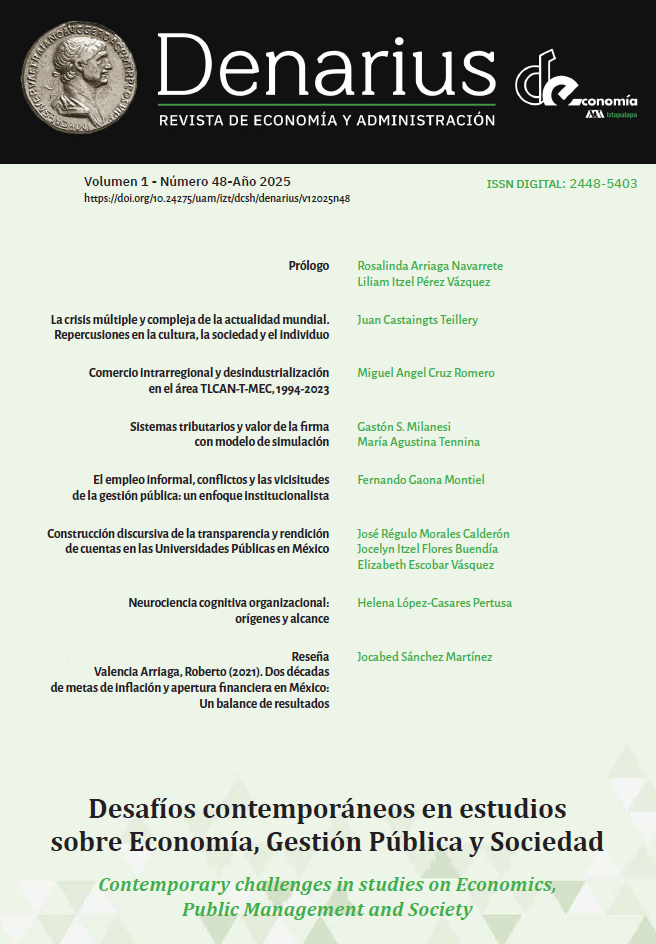Sistemas tributarios y valor de la firma con modelo de simulación
Abstract
In the valuation of risky securities, the relationship between required return and risk is essential. The risk of not diversifying impacts the value of the firm, so its analysis must be considered when making the calculation. Considering different tax systems, the impact of variations in the risk of not diversifying the investment, in the value of the leveraged firm and in the weighted average cost of capital will be analyzed. In order to provide greater realism to the analysis, different scenarios of results (contingent results) will be considered. The results allow to expose the linear relationship between risk and value of the firm (CAPM model) and between required return on capital and risk.
Downloads
References
Arzac, E- Glosten, L. (2005). A reconsideration of tax shield valuation. European Financial Management, 11(4), 453-461. doi:.org/10.1111/j.1354-7798.2005.00292.x
Booth, L. (2007). Capital cash flows. APV, and valuation. European Financial Management, 13(1), 29-48. doi:org/10.1111/j.1468-036X.2006.00284.x
Castillo, A-Niño, J-Zurita, S. (2016). Debt tax shields around the OECD world. Emerging Markets Finance and Trade, 53(1), 26-43. doi:10.180/1540496X.206.1145112
Conine T. E. (1980) Corporate debt and corporate taxes: An extension, Journal of Finance, 35(4). 1033-1037. RePEc:bla:jfinan:v:35:y:1980:i:4:p:1033-37
De Angelo, H-Masulis,R. (1980). Optimal capital structure under corporate and personal taxation. Journal of Financial Economics, 8(1), 3-29. doi:10.1016/0304-405X(80)90019-7.
Damodaran, Aswath, Country Risk: Determinants, Measures and Implications - The 2022 Edition (July 5, 2022). Available at SRN: https://ssrn.com/abstract=4161010 or http://dx.doi.org/10.2139/ssrn.4161010
Dempsey, M. (2019). Discounting methods and personal taxes. European Financial Management, 25(2), 310-324. doi:.org/10.1111/eufm.12157
Fama E. F. y French K. R. (2004), The capital asset pricing model: Theory and evidence, Journal of Economic Perspectives, 2004.
Fernández, P. (2005). The value of tax shields is not equal to the present value of tax shields: a correction. WP SSRN, 1-8. Obtenido de https://ssrn.com/abstract=651206
Fernández, P. (2023). Valuation and Common Sense (8th edition) (May 1, 2023). Available atSSRN: https://ssrn.com/abstract=2209089 or http://dx.doi.org/10.2139/ssrn.2209089
Graham, J., Smith, C. (1999) Tax Incentives to Hedge. First published: 17 December 2002 https://doi.org/10.1111/0022-1082.00187
Graham, J. (2003). Taxes and corporate finance: A review. The Review of Financial Studies, 16(4), 1075-1029. doi: :10.1093/rfs/hhg033
Graham, J. (2008). Taxes and corporate finance. In Handbook of empirical Corporate Finance. Elsevier.
Hamada, R. (1972). The effect of the firm´s capital structure on the systemtic risk of common stocks. The Journal of Finance (27) 2 435-452 doi.org/10.1111/j.1540-6261.1972.tb00971.x
Kumar, S., Kumar, A., Singh, K y Patra, S. (2023). The six decades of the Capital Assets Pricing Model: a researga agenda. Journal of Risk and Financial Management 16(8) 1-15 doi.org/10.3390/jrfm16080356
Massari, M-Roncaglio, F-Zanetti, L. (2007). On the equivalence between the APV and the wacc approach in a growing leveraged firm. European Financial Management, 14(1), 152-162. doi:10.1111/j.1468-036x.2007.00392.x
Miles, J-Ezzell, J. (1985). Reformulation tax shield valuation: a note. The Journal of Finance, 40(5), 1485-1492. doi:org/10.1111/j.1540-6261.1985.tb02396.x
Miller, M. H. (1977). Debt and Taxes. The Journal of Finance, 13(4), 261-297. doi:.org/10.1111/j.1540-6261.1977.tb03267.x
Modigliani, F-Miller, M. (Junio de 1958). The cost of capital, corporation finance and the theory of investment. American Economic Review, 48(3), 261-297. Obtenido de www.jstor.org/stable/1809766
Modigliani, F-Miller M. (Junio de 1963). Corporate income taxes and cost of capital: a correction. American Economic Review, 53(3), 433-443. Obtenido de www.jstor.org/stable/1809167
Molnár, P-Nyborg, K. (2011). Tax-adjusted discount rates: a general formula under constant leverage ratios. European Financial Management, 19(3), 419-428. doi:.org/10.1111/j.1468-036X.2011.00619.x
Milanesi, G. (2020). Opciones reales y el valor de los ahorros fiscales. Ciencias Administrativas, 8(16), 61-70. 10.24215/23143738e063
Myers, S. (1974) Interactions of Corporate Financing and Investment Decisions – Implications for Capital Budgeting, The Journal of Finance 29(1), 1–25 doi.org/10.2307/2978211
Niño, J-Zurita, S-Castillo, A. (2014). Costo del capital e impuestos en un sistema tributario no integrado y en uno integrado: Generalización del modelo. El Trimestre Económico, 81(321), 109-132. doi:doi.org/10.20430/ete.v81i321.110.
Ruback, R. (2002). Capital Cash Flow: A simple approach to valuing risky cash flows. Financial Management, 31(2), 85-103. doi:.org/10.2307/3666224
Sick, G. (1990). Tax-adjusted discount rates. Management Science, 36(12), 1432-1450. doi:org/10.1287/mnsc.36.12.1432
Taggart, R. (1991). Consistent valuation and cost of capital expressions with coporate and personal taxes. Financial Management, 20(3), 8-20. doi:org/10.2307/3665747
Copyright (c) 2025 Denarius

This work is licensed under a Creative Commons Attribution-NonCommercial-ShareAlike 4.0 International License.














